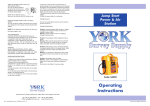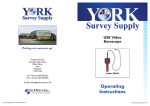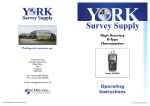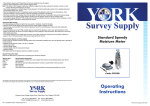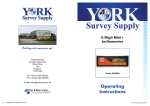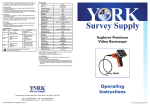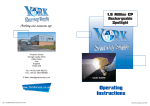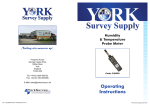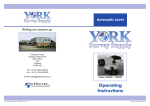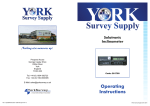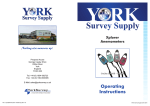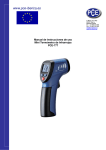Download Operating Instructions - York Survey Supply Centre
Transcript
Nothing else measures up! Prospect House George Cayley Drive Clifton Moor York England YO30 4XE Tel: +44 (0) 1904 692723 Fax: +44 (0) 1904 690385 E-Mail: [email protected] ...for secure online ordering of all our products! Ref:.. \operat98\instructions 15\320630.qxp 05-01-15 Infrared Thermometer Code: 320630 Operating Instructions ©York Survey Supply Centre 2015 Features: • Precise non-contact measurements • Built-in laser pointer • Resolution to 0.1º • CAL (caution temperature setting) button • Green LED normal temperature indication and red LED high temperature caution • Automatic data hold and auto power off • The meter at 8 inches away measure 1 inch target • Backlit LCD display Wide range application: Food preparation, safety and fire inspectors, plastic moulding, asphalt, marine and screen printing, measure ink and dryer temperature, diesel and fleet maintenance. This instrument can measure body heat surface temperature. Field of view Meter’s field of view is 8:1, meaning that if the meter is 8 inches from the target, the diameter of the object under test must be at least 1 inch. Other distances shown below in the field of view diagram. Refer to the chart printed on the meter for more information. 1. SAFETY • Use extreme caution when the laser beam is turned on. • Do not let the beam enter your eye, another person’s eye or the eye of an animal. • Be careful not to let the beam on a reflective surface strike your eye. • Do not allow the laser light beam impinge on any gas which can explode. Range Resolution -50.0ºC to -20.0ºC (-58.0ºF to -4.0ºF) 0.1ºC -20.0ºC to 199.9ºC (0.1ºF) (-4.0ºF to 199.9ºF) -50.0ºC to 199.9ºC (-58.0ºF to 199.9ºF) Accuracy ±5ºC (±9ºF) ±2% rdg or ±2ºC (±4ºF) • Infrared Thermometer specifications Note: Accuracy is given at 18ºC to 28ºC (64ºF to 82ºF), less than 80%RH. Field of view Make sure the target is larger than the unit’s spot size. The smaller the target, the closer you should be to it. When accuracy is critical, make sure the target is at least twice as large as the spot size. Emissivity: Forehead Temperature Range Resolution Accuracy 30.0ºC~45.0ºC 0.1 ±0.4ºC Contrasting form of forehead and actual body temperature: (data in the table is only for reference) Forehead temp. 34.0ºC 35.0ºC 35.6ºC 35.8ºC 36.0ºC 36.2ºC 36.4ºC 37.0ºC Actual temp. 36.2ºC 37.0ºC 37.5ºC 37.7ºC 37.8ºC 38.0ºC 38.1ºC 38.5ºC NOTES: 1. Don’t wear caps or cover forehead when measuring (respirator mask is allowed). 2. When measuring the surface of forehead, make sure the meter points to the centre of forehead and keep vertical! Hair or other objects on the measuring position will influence the measuring results. 3. When measuring people or objects from outdoors or places where the temperature is very different from the measured ambient temperature, he should stay in the measuring condition for at least 2 minutes until the temperature is the same as the ambient, or the result will be influenced. 4. If the meter is taken out from the place where the temperature is very different from measured ambient temperature, please put it in the measured environment for at least 20mins before use. 0.95 fixed value 2. SPECIFICATIONS • General specifications DISPLAY MEAS. RANGES SAMPLE RATE OVER RANGE INDICATION POLARITY 3½ digit (1999 count) LCD with backlighting -50.0ºC to 199.9ºC (-58.0ºF to 199.9ºF) 2.5 times per second LCD will show “1” Automatic (no indication for positive polarity); Minus (-) sign for negative polarity EMISSIVITY 0.95 fixed value FIELD OF VIEW D/S = Approx. 8:1 ratio (D=distance, S=spot) (Has 90% encircled energy at the focal point) DIODE LASER Output <1mW, Wavelength 630-670nm, class 2 (II) laser product SPECTRAL RESPONSE 6-14um POWER-OFF Automatic shut-off after 7 seconds, approx. OPERATING TEMP. 0ºC to 50ºC (32ºF to 122ºF) STORAGE TEMP. -20ºC to 60ºC (-4ºF to 140ºF) RELATIVE HUMIDITY 10%~90%RH operating, <80%RH storage POWER SUPPLY 9V battery, NEDA 1604A, IEC 6LR61, or eqvt. WEIGHT 180g SIZE 82 x 41.5 x 160mm Ref:.. \operat98\instructions 15\320630.qxp 05-01-15 3. FRONT PANEL DESCRIPTION 1. IR Sensor 2. Laser pointer beam 3. LCD display 4. Laser select key 5. CAL button 6. Green LED normal temperature indication and red LED high temperature caution 7. Backlight select key 8. Measurement trigger 9. Battery cover 10. Handle grip 4. INDICATOR 1. Digital readout 2. Temperature ºC (Celsius) 3. Measuring indication 4. Data hold 5. LOW battery indicator 6. Laser point 5. MEASUREMENT OPERATION 1. Hold the meter by it’s handle grip and point it toward the surface to be measured. If it’s up to or above the preset caution temperature (such as: temp>36.5ºC), the red caution light will turn on while the green off, and the alarm will sound “di di”. 2. Pull and hold the trigger to turn the meter on and begin testing. The display will light if the battery is good. Replace the battery if the display does not light. 3. While measuring, the SCAN display icon will appear in the upper left hand corner of the LCD. 4. While continuing to pull the trigger: a. Push the Laser button to turn on the laser pointer. When the laser is on the laser icon will appear on the LCD over the temperature. Aim the red beam approximately a half inch above the point of test (pressing the laser button again turns the laser off). b. Push the Backlight key to turn on the LCD backlighting function. 5. Release the trigger and the HOLD display icon will appear on the LCD indicating that the reading is being held. 6. The meter will automatically power down after approximately seven seconds after the trigger is released. FOREHEAD TEMPERATURE MEASUREMENT OPERATION 1. Hold the handle grip of the meter and point to the centre of the forehead, the measuring distance<10cm, the measuring time<3s. 2. Pull the measuring trigger, the thermometer will power on automatically and show the data on the LCD indicator. If the temperature is normal, the green light will turn on; and if it’s up to or above the preset caution temperature (such as: temp>36.5ºC), the red caution light will turn on while the green off, and the alarm will sound “di di”. Note: Measurement considerations Holding the meter by it’s handle, point the IR sensor toward the object whose temperature is to be measured. The meter automatically compensates for temperature deviations from ambient temperature. Keep in mind that it will take up to 30 minutes to adjust to wide ambient temperatures are to be measured followed by high temperature measurements, some time (several minutes) is required after the low (and before the high) temperature measurements are made. This is a result of the cooling process which must take place for the IR sensor. Note: the caution temperature (CAL) has been set when the meter was produced in the factory, CAL=36.5ºC - is probably equal to the body temperature 38.15ºC. 6. BATTERY REPLACEMENT 1. As battery power is not sufficient, LCD will display “ -+ “ replacement with one new battery type 9V is required. 2. Open battery cover, then take out the battery from instrument and replace with a new 9-Volt battery and place the battery cover back. NOTES: How it Works Infrared thermometers measure the surface temperature of an object. The unit’s optics sense emitted, reflected and transmitted energy, which is collected and focussed onto a detector. The unit’s electronics translate the information into a temperature reading which is displayed on the unit. In units with a laser, the laser is used for aiming purposes only. Field of View Make sure the target is larger than the unit’s spot size. The smaller the target, the closer you should be to it. When accuracy is critical, make sure the target is at least twice as large as the spot size. Distance and Spot Size As the distance (D) from the object increases, the spot size (S) of the area measured by the unit becomes larger. See fig: 1. Locating a Hot Spot To find a hot spot aim the thermometer out side the area of interest, then scan across with an up and down motion until you locate hot spot. Reminders 1. Not recommended for use in measuring shiny or polished metal surfaces (stainless steel, aluminium, etc.) See Emissivity. 2. The unit cannot measure through transparent surfaces such as glass. It will measure the surface temperature of the glass instead. 3. Steam, dust, smoke, etc. can prevent accurate measurement by obstructing the unit’s optics. Emissivity Most (90% of typical applications) organic materials and painted or oxidised surfaces have an emissivity of 0.95 (pre-set in the unit). Inaccurate readings will result from from measuring shiny or polished metal surfaces. To compensate, cove the surface to be measured with masking tape or flat black paint. Allow time for the tape to reach the same temperature as the material underneath it. Measure the temperature of the tape or painted surface. Emissivity Values Substance Asphalt Concrete Cement Sand Earth Water Ice Snow Glass Ceramic Marble Plaster Mortar Brick Thermal emissivity 0.90 to 0.98 0.94 0.96 0.90 0.92 to 0.96 0.92 to 0.96 0.96 to 0.98 0.83 0.90 to 0.95 0.90 to 0.94 0.94 0.80 to 0.90 0.89 to 0.91 0.93 to 0.96 Substance Thermal emissivity Cloth (black) 0.98 Human skin 0.95 to 0.98 Leather 0.75 to 0.80 Charcoal powder 0.96 Lacquer 0.80 to 0.95 Lacquer (matt) 0.97 Rubber (black) 0.94 Plastic 0.85 to 0.95 Timber 0.90 Paper 0.70 to 0.94 Chromium oxides 0.81 Copper oxides 0.78 Iron oxides 0.78 to 0.82 Textiles 0.90 ©York Survey Supply Centre 2015


